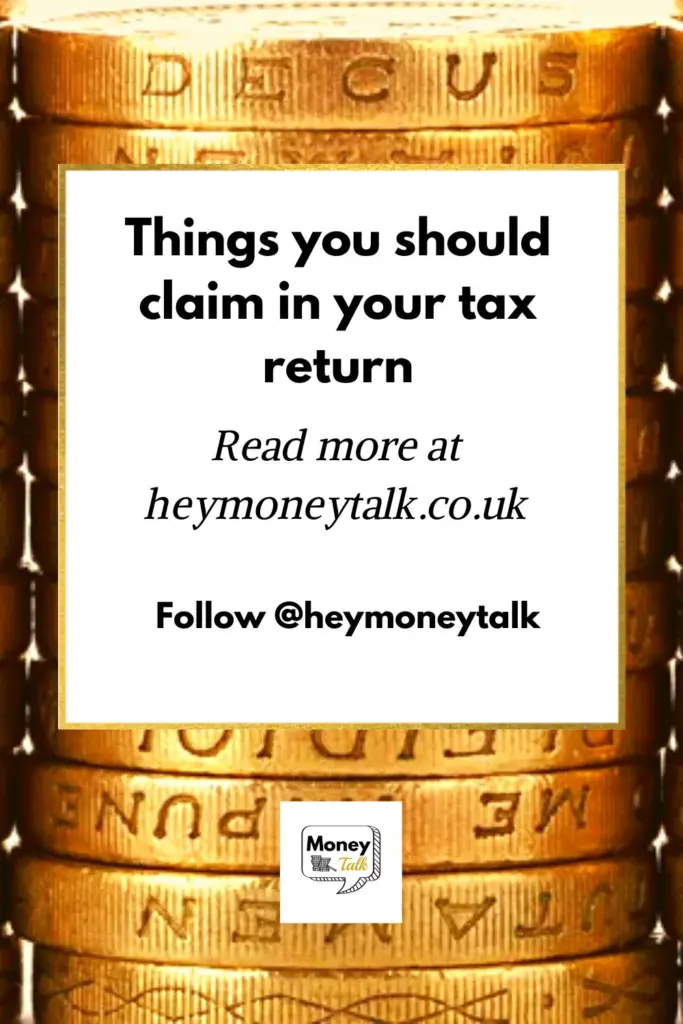Things you should claim in your tax return
Money Talk is intended to inform and educate; it's not financial advice. Affiliate links, including from Amazon, are used to help fund the site. If you make a purchase via a link marked with an *, Money Talk might receive a commission at no cost to you. Find out more here.
The deadline for filing your self assessment tax return digitally is coming up later this month.
While chiefly intended for those who are self employed, you may also need to file one if you’re an employee.
This includes if you’re a landlord making more than £2,500 a year after expenses, if you earn over £1,000 in other income (including if you sell stuff on sites like Ebay or Vinted), or if you have capital gains tax to pay.
But in some cases, it might be worth doing a self assessment tax return even if none of the above apply to you, because some forms of tax relief can only be claimed this way.
Here are three things you should be claiming in your tax return.
A quick disclaimer: tax laws can be particularly complicated, and if you’re not certain, you should always consult a qualified accountant who’s familiar with your line of work. They might even be able to suggest other tax benefits that are suitable for your situation.
Pension tax relief
When you’re a basic rate taxpayer, the tax relief applicable to pensions is automatically applied.
However, if you’re a higher rate or additional rate taxpayer, you have to file a self assessment and claim this separately.
Sean McCann, a chartered financial planner at NFU Mutual, explained: “When you pay into your pension, for every £80 you pay in, your pension provider will get another £20 direct from HMRC.
“If you pay 40% or 45% income tax you’ll need to claim the extra 20% or 25% tax relief via your tax return.
“Many higher and additional rate taxpayers do not do this, potentially missing out on thousands of pounds in unclaimed tax relief.
“If you haven’t claimed on previous year’s tax returns, you can go back up to four years and claim any higher rate relief due by contacting HMRC directly.”
Charitable donations
Higher and additional rate taxpayers who donate to charity are also eligible for tax relief.
However, you must make a Gift Aid declaration.
This allows the charity to claim tax relief on that donation and therefore get more money.
At the same time, it also does the equivalent of extending your tax bracket, meaning more of your income is taxed at a lower rate.
That said, it obviously makes more sense to claim if you’ve made significant monetary contributions to charity.
And donated goods don’t count towards this, although proceeds from the sale of the goods could if the charity shop is acting as your agent in the sale of the product.
Working from home
The big new expense during the Covid period was of course the additional cost of working from home.
You can make a claim to reduce these costs, although the process and the rules are slightly different depending on whether you’re employed under PAYE rules or self employed.
The rules have also been updated since Covid.
Work from home expenses for employees
For employees, you can declare the expense in one of two ways:
- a £6 a week flat rate (no additional bookkeeping needed); or
- the exact amount of extra expense incurred (you’ll need to show evidence of this)
You’ll receive tax relief on that expense based on your tax bracket.
So if you declare £6 a week for 52 weeks and pay the basic income tax of 20%, you’ll get back £62.40 in a year. And if you pay a higher rate of tax, you’ll get more of that money back.
Note that the rules around this tax relief changed on 6 April 2022, which affects eligibility.
Under the new rules, you can only make a claim if you have to work from home (for example if you work for a remote employer or you live too far from the office), rather than because you choose to work from home.
Work from home expenses for self employed workers
If you’re self employed and work from home, you can also choose between working out your exact expense or using a flat rate.
In addition, you’ll be able to claim that entire sum as a business expense rather than just receive a tax relief.
The flat rate is called simplified expenses, and you just claim the same amount each month depending on the number of hours you work from home.
Things like your broadband and telephone bills are separate, so you can make an additional claim for these.
Working out your exact expenses will take a bit more work. You’ll need to add up things like your utility bills, council tax and mortgage interest or rent, and then proportion it according to how much you work from home.
Depending on the size of your bills, you may be able to claim significantly more money back, especially if the size of your electricity bill has skyrocketed as a result of the energy crises.
The government has a simple form that can work out roughly which option is better for you.
Read this: How to save money while working from home
Updates and corrections to your tax return
If you’re reading this after you’ve just filed your tax return, fret not – it is possible to make corrections after you file.
You can update your return online three days after you file your self assessment, and can make changes within the first 12 months.
If you do make any changes, you’ll need to check your tax statement again after three days to make sure there hasn’t been any changes to the amount of tax you owe.
Read this: Tips for filing tax return for the first time
This post was originally published in January 2022. It was updated in January 2025.
Pin this for later







